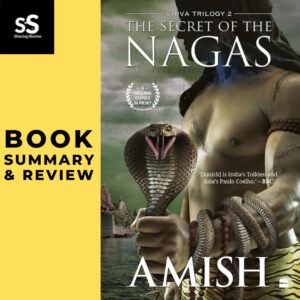The secret of nagas book review
The Secret of the Nagas is the second installment in the captivating Shiva Trilogy written by Amish Tripathi. This fantasy novel delves deeper into Indian mythology, blending fiction with ancient lore. Released in 2011, the book received widespread acclaim for its unique narrative and intricate world-building.

Table of Contents
Introduction to the Book
- The Secret of the Nagas continues the journey of Shiva, the Neelkanth, as he unravels the mysteries surrounding the enigmatic Nagas.
- Author: Amish Tripathi is renowned for his fresh take on Indian mythology, infusing modern storytelling with timeless legends.
The Plot of The Secret of Nagas
The storyline of “The Secret of the Nagas” follows Shiva as he encounters the Nagas, a secretive and powerful group with a mysterious agenda. As Shiva delves deeper into their world, he discovers shocking truths that challenge his perception of good and evil.
Summary of the Storyline
- Shiva: The protagonist, known as the Neelkanth, embarks on a quest to seek justice and truth amidst political intrigue and mythical beings.
- Nagas: These mystical serpent-like beings play a crucial role in Shiva’s journey, blurring the lines between friend and foe, adding layers of complexity to the narrative.
Main Characters and Their Roles
- Shiva: The fierce warrior and reluctant hero who grapples with his destiny.
- Sati: Shiva’s beloved wife, a source of strength and wisdom.
- Nagas: Mysterious beings with intricate motives that shape the course of events.
Key Themes and Symbols
The narrative of “The Secret of the Nagas” delves into profound themes and symbols that resonate with readers, such as:
Good vs. Evil
- The exploration of morality and blurred lines between righteousness and darkness.
- Ethical dilemmas that challenge characters’ beliefs and actions.
Mythology and Folklore
- Indian mythology woven intricately into the plot, enriching the story with cultural depth.
- Folkloric elements that add mystical allure to the narrative.
Symbolism in the Narrative
- Metaphorical representations that enhance the thematic depth and add layers of meaning.
- Symbolic motifs that resonate beyond the surface, inviting readers to contemplate deeper interpretations.
Writing Style and Language
Amish Tripathi’s writing style in “The Secret of the Nagas” stands out for its:
- Narrative Structure: Intricately woven storyline that keeps readers intrigued and engaged.
- Language and Prose: Captivating prose that blends modern storytelling with mythological richness.
Analysis of Character Development
- Amish Tripathi explores character growth in “The Secret of the Nagas” with depth and complexity.
- Amish Tripathi delves into the psyche of major characters such as Shiva and Sati, portraying their evolution in response to the challenges they face.
Exploration of Moral Dilemmas
- The narrative in “The Secret of the Nagas” raises thought-provoking ethical questions.
- Moral ambiguity is a recurring theme as characters navigate through decisions with unforeseen repercussions.
Discussion on World-building
- Amish Tripathi intricately weaves a vivid tapestry of settings, incorporating mystical elements and creatures.
- The detailed description of Indian mythology adds layers of richness to the world depicted in the story.
Themes of Identity and Destiny
- Identity crises and quests for destiny are central motifs in “The Secret of the Nagas.”
- Characters grapple with the age-old conflict of fate versus choice, adding philosophical depth to their journeys.
Unanswered Questions and Future Speculations
- The book leaves several intriguing loose ends, hinting at the potential for a captivating sequel.
- Fans are left speculating about the unresolved mysteries and eagerly await further revelations in upcoming installments.
Fan Theories and Speculations
- Enthusiastic fans have crafted diverse interpretations and engaging predictions about the future trajectory of the series.
- The vast array of fantastical elements in the narrative fuels exciting discussions and theorizing among readers.
FAQs:
What is the main theme of The Secret of the Nagas?
The main theme of The Secret of the Nagas revolves around the eternal conflict between good and evil, drawing heavily from Indian mythology and folklore to create a rich narrative tapestry.
How does the character development progress in the book?
The character development in The Secret of the Nagas is intricate and profound, with major characters experiencing growth, facing moral dilemmas, and embarking on personal journeys that shape their destinies.
What sets The Secret of the Nagas apart from other fantasy fiction novels?
The unique blend of Indian mythology, philosophical themes, and fantastical elements distinguishes The Secret of the Nagas as a standout work of mythological fiction that offers readers a fresh and captivating narrative.
What is the significance of the Naga tribe in the story?
The Naga tribe plays a pivotal role in the narrative, adding layers of mystery, intrigue, and cultural relevance to the story, contributing to the overall depth and complexity of the plot.
How does The Secret of the Nagas contribute to the fantasy genre?
The Secret of the Nagas contributes to the fantasy genre by introducing readers to a culturally rich and immersive world filled with mythical creatures, moral ambiguity, and epic adventures that resonate with audiences seeking a blend of tradition and innovation.
Does The Secret of the Nagas leave room for sequels or future installments?
The ending of The Secret of the Nagas offers intriguing possibilities for sequels and future developments, leaving fans eagerly anticipating the continuation of the saga and the exploration of new story arcs.
Final Verdict and Recommendations
- “The Secret of the Nagas” offers a compelling continuation to the Shiva Trilogy, delivering a blend of mythological fiction and epic fantasy.
- For readers who enjoy mythological epic sagas with philosophical themes and fantastical elements, this book is highly recommended.
By focusing on character development, moral dilemmas, world-building, themes of identity and destiny, unanswered questions, fan theories, and providing a final verdict and recommendations, this segment of the review offers a comprehensive analysis that caters to literary exploration enthusiasts and fans of epic fantasy fiction.




